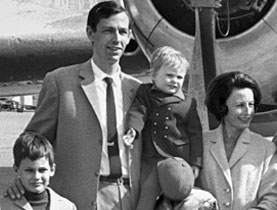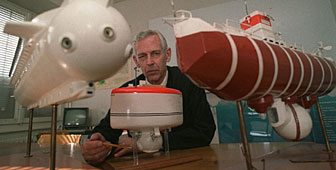A family piles up the records

Up in the air or down in the deep, breaking records is what the Piccard family has been good at for three generations.
But their record-setting projects have all served the purpose of research, and the current representative, Bertrand, is no exception.
He is now working on the Solar Impulse aircraft with which he plans to make the first ever solar-powered round-the-world flight. The prototype was unveiled in June, and the plane is scheduled to make its ambitious flight in 2012.
Harnessing natural forces is nothing new for him: he has already been round the world propelled by the wind. He and co-pilot Brian Jones of Britain made the first ever non-stop flight in a hot air balloon in 1999.
Their Breitling Orbiter 3 took off from the Swiss balloon mecca, Château-d’Oex , on March 1 and landed just 20 days and 45,755 kilometres later in the Egyptian desert.
“The sophisticated technology that had to be developed was aimed solely at better understanding our atmosphere in order to use nature as an ally,” says Piccard’s website.
Hang-gliding pioneer
It is scarcely surprising that Bertrand Piccard’s eyes turned skywards. As a child, when his father was working in the United States, he met such legends as the flying pioneer Charles Lindbergh, Hermann Geiger, who developed the art of landing on glaciers, and rocket designer Wernher von Braun.
When he started to fly himself, it was in hang gliders and microlight aircraft. He was a pioneer of such flights in Europe, and became the European champion in hang-glider acrobatics.
But it wasn’t just a thirst for records or for thrills that attracted Bertrand Piccard to microlights. He saw the sport as a kind of psychology laboratory where human behaviour in extreme situations could be studied.
Piccard trained as a psychiatrist, in order to gain a deeper understanding of this “inner world”. Hypnosis was one of the subjects that he studied and learned to value as a way of overcoming extreme situations.
From psychiatry to ballooning
It was Piccard’s reputation as a specialist in hypnosis which brought him to balloons in 1992. The Belgian Wim Verstraeten persuaded him to act as co-pilot in the Chrysler Challenge, the first trans-Atlantic race for hot air balloons.
Verstraeten thought the techniques of hypnosis might help them to withstand the rigours of the 5000 kilometre trip. And he was proved right – or at any rate, the pair won the race, landing in Spain after five days.
Bertrand’s interest in hypnosis would doubtless have pleased his great grandfather Jules, who was also interested in the “inner world”.
Jules Piccard was a chemistry professor at the university of Basel who conducted research into chrysin, a substance extracted from passion flower, which was thought to be a remedy for anxiety.
Highs and lows
Jules’ son, Bertrand’s grandfather, the physicist and inventor Auguste Piccard reached the heights and plumbed the depths.
In 1932 he and his Belgian assistant Max Cosyns set a world record for an ascent in a balloon, rising to a height of 16,201 metres from Dübendorf in Switzerland.
The experience of designing the pressure capsule for the balloon helped him after the war when he came to build the deep-sea submersible, the bathyscaphe “Trieste”.
In 1953, the year it was launched, Auguste and his son – and co-designer – Jacques set a new world record by taking it down to a depth of 3,150 metres in the Tyrrhenian Sea, with the aim of exploring deep marine life.
To the deepest point on Earth
That record was soon broken by a French bathyscaphe, but in 1960 Jacques Piccard set a record that still stands nearly 50 years later: together with Don Walsh of the US Navy he went down to a depth of 10,916 metres in the Mariana Trench in the Pacific.
Auguste and Jacques Piccard subsequently worked together on the mesoscaphe “Auguste Piccard”, designed by the father and built by the son. It turned out to be one of the main attractions at the 1964 national exhibition in Lausanne.
It was the first and largest-ever submarine built for pleasure trips, and took some 33,000 passengers down to the bottom of Lake Geneva and back.
Afterwards it was used for oceanographic research, and was on show again nearly 40 years later – in a sadly rusted condition – at the follow-up exhibition Expo 02. It can now be seen at the Swiss Museum of Transport in Lucerne.
Following the Gulf Stream
In 1969 Jacques Piccard started to conduct research into the Gulf Stream, using the submarine “Ben Franklin” which he designed especially for the project. Six scientists allowed themselves to be carried by the Gulf Stream at a depth of about 300 meters below the surface.
The information collected about the mental effects on the scientists of being cooped up for such a long journey was of great assistance to NASA in preparing the Skylab missions and space shuttle programmes.
Jacques Piccard remained fascinated by the ocean depths and the animals and plants that live far below the surface. He established a foundation whose purpose was to encourage research into marine life and ways to preserve it.
At the age of 82 Piccard was still taking part in deep sea expeditions. He died in November 2008 in his house on Lake Geneva.
Six years of work, calculations, simulations and tests were needed by the 70-person team to complete Bertrand Piccard’s solar-powered aircraft.
It has the wingspan of a Boeing 747-400 and weighs 1,600kg – about the same as an average family car.
The 12,000 solar cells mounted onto the wing will supply energy to the four electric motors which have a maximum power of 10 HP each.
During the day they will also charge the polymer lithium batteries (400kg), which will allow the aircraft to fly at night.
A prototype was unveiled in 2009, and the first night flight is planned for 2010.
It is due to fly round the world in 2012.
The plane was developed in cooperation with the Federal Institute of Technology in Lausanne.
The aim is to promote the use of renewable energy.
Auguste Piccard (1884-1962) was the first man to reach the stratosphere in a balloon and invented the deep diving vessel he called a “bathyscaphe”.
He was the model for Professor Calculus in the Tintin comic books. Author Hergé described him as the “archetypal scientist.”
His son, Jacques (1922-2008), worked with his father, and in 1960 made the deepest dive in history, to 10,915 metres.
Bertrand Piccard (1958- ) and his co-pilot Brian Jones were the first men to circumnavigate the world non-stop in a hot air balloon.
Auguste’s twin brother, Jean, was also a balloonist and balloon engineer. He died in 1963. Captain Jean-Luc Picard in Star Trek is named after one or both of the twins.
Jean’s son, Don, carried on the family ballooning tradition in the US, working on a number of technical innovations and pioneering ballooning as a sport.
(Adapted from German by Julia Slater)

In compliance with the JTI standards
More: SWI swissinfo.ch certified by the Journalism Trust Initiative













You can find an overview of ongoing debates with our journalists here . Please join us!
If you want to start a conversation about a topic raised in this article or want to report factual errors, email us at english@swissinfo.ch.